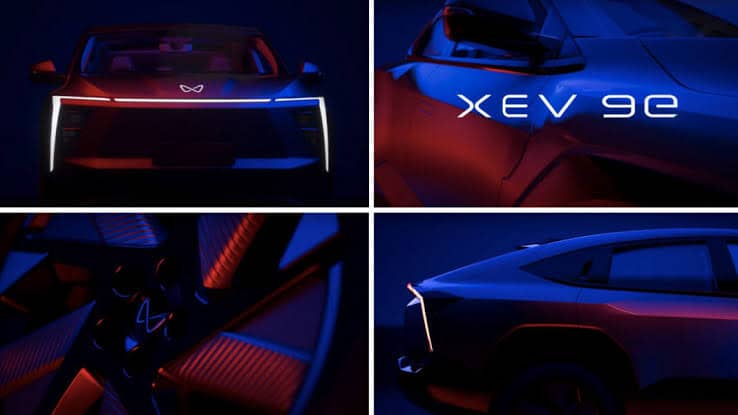Mahindra XEV 9e, BE 6e electric SUVs launched in India. Starting at ₹ 18.90 lakh
It is another shared underpinning, this time for the Mahindra XEV 9e and BE 6e electric SUVs, which join the previously announced XUV400 compact electric SUV in Mahindra’s plan.
Mahindra today launches the XEV 9e and BE 6e electric SUVs in India. The Mahindra XEV 9e is priced at ₹21.90 lakh (ex-showroom), and the BE 6e is priced at ₹18.90 lakh (ex-showroom). The new electric SUVs join the automaker’s XUV400 compact electric SUV. Additionally, with these two electric cars, the homegrown auto major launched the two sub-brands XEV and BE as well. This electric SUV will enter the market from January 2025. Deliveries of this vehicle are likely to begin around February and March next year.
From the same INGLO platform that forms part of an EV-exclusive modular architecture to support a few more upcoming Mahindra electric cars, the Mahindra XEV 9e draws upon a triangular LED headlamp design, LED DRLs running across the width of the SUV, along with an inverted L-shaped interconnected LED DRLs and sleek LED taillights. There are also more design features in the form of an illuminated logo and a butch look.
Today, the Mahindra BE 6e is available with a contemporary design philosophy, which includes sharp character lines, stumpy wheel arches, C-shaped LED DRLs, and a sleek bumper. The SUV is complemented with a hood scoop to ensure aerodynamic efficiency and an illuminated BE emblem on the hood. The SUV also comes with aerodynamically optimized 20-inch wheels.
The Mahindra XEV 9e and BE 6e are offered with driver-focused cabins. The carmaker says it has drawn inspiration from fighter jets for designing the cabin of these SUVs. A notable feature inside the XEV 9e cabin is a triple screen setup comprising three 12.3-inch displays powered by Mahindra’s Adrenox software. The BE 6e features two screens which are of the same size. The XEV 9e will boast of a wireless smartphone charger, an ADAS suite, and a panoramic sunroof. The Mahindra BE 6e will have an illuminated logo and a large sunroof. Additionally, the SUV boasts of an ADAS suite as well as a 360-degree camera. The cabin of these SUVs will also boast of an essential feature, which is the 16-speaker Harman Kardon audio system.
The Mahindra INGLO platform supports two different battery pack options, namely a 59 kWh and a 79 kWh unit. Initial versions of the products available will only contain the more modest variants with the smaller battery packs. Mahindra XEV 9e and BE 6e will come with lithium iron phosphate (LFP) battery packs, offering improved protection against thermal phenomena. Coming with rapid charging abilities, both the electric SUVs can charge up to 20-80% in just 20 minutes and need a 175 kW DC fast charger for it. Their electric powertrain delivers a maximum of 224 bhp and 278 bhp, and the powertrain will have a 79 kWh battery pack that can travel over 500 km on a single charge.
#What are the greatest variations between Mahindra XEV 9e and the BE 6e?
Mahindra XEV 9e and BE 6e differ primarily through design, interior and target markets:
-Design: The XEV 9e has a muscular SUV profile with a co-body roofline that is highlighted by connected LED lightbars. The BE 6e gives a sharper, more aggressive look, with C-shaped DRLs.
-Interior Design: The XEV 9e variant features a triple-screen set layout for infotainment, while the BE 6e possesses a dual-screen driver-centric set layout.
-Target Customer: It is for a younger audience based on the sporty appeal of the BE 6e. The XEV 9e, on the other hand, has been designed specifically for the family market with emphasis on comfort and luxury.
Both the models operate based on the same INGLO platform and subsequently possess similar performance specs and battery options.
READ ALSO: 15 Best places in Europe for a perfect family trip
READ ALSO: Top 15 best things to do in Seattle (2024)
#Expected Performance Capabilities for the XEV 9e and BE 6e?
Mahindra XEV 9e and BE 6e shall be endowed with impressive performance capabilities:
-Power Output: Both of these models shall feature rear-wheel configurations, power out-puts ranging from 231 PS to 285.5 PS, or roughly 228-282 hp, depending on what battery pack gets chosen.
-Battery Sizes: Both will be mated with either a 59 kWh or 79 kWh battery and claim to be able to drive between 450 and 500 km on a single charge.
-Charging Speed: The two models can charge from 20% to 80% in just 20 minutes with 175 kW DC Fast Charging.
The XEV 9e and BE 6e position themselves as capable entrants in the electric SUV market.
#What are top speeds for XEV 9e and BE 6e?
The top speed of Mahindra XEV 9e and BE 6e would be achieved at up to 130 km/h. Both are rear-wheel drive models and feature a one-speed transmission but provide a wide range of power output from 228 bhp to 282 bhp. Both are targets at efficient performance so that 0 to 100 km/h acceleration time stands below seven seconds, as both are in point of emphasizing sportiness capability but also practical for use in daily life.
#How does the XEV 9e top speed rank with other SUVs in this class?
-Mahindra XEV 9e and BE 6e have a top speed of 130 kmph. This is how it stacks up with its competitors in the electric SUV category:
-Tata Nexon EV : Top speed of around 120 kmph
-MG ZS EV : Top speed of around 140 kmph.
-Hyundai Kona Electric: Its top speed is almost at approximately 167 km/h.
Where the XEV 9e and BE 6e equal or surpass some competitors, they trail behind Hyundai Kona Electric. Therefore, they may be quite suitable for city and suburb runs without sacrifice to performance.
#How does the high top speed of the XEV 9e impact its fuel economy?
A higher speed of 130 km/h could alter the fuel efficiency of Mahindra XEV 9e, where fuel efficiency is likely to increase with a more raised speed. Electric cars like XEV 9e commonly operate most efficiently at moderate speeds-ranging between 50-80 km/h. Higher speeds might result in increased aerodynamic drag and loss of energy with an overall reduced range. However, Mahindra has optimized the designs in such a way that effects of these top speed capacities are reduced, and the claimed range is 450 to 500 km notwithstanding.
#What aerodynamic features aid XEV 9e to its top speed?
The Mahindra XEV 9e has the following aerodynamic elements in designing the vehicle to have increased top speed efficiency:
-Coupe-like Roofline: It allows smoother airflow over the vehicle and helps to reduce drag, thus further contributing to improved stability at higher speeds.
-Inverted L-shaped LED DRLs: These add an aesthetic value to the vehicle along with directing airflow around the vehicle when placed intelligently.
-Aerodynamically Optimized Wheels: The alloy wheels help to reduce turbulence, hence further aiding the efficiency of the vehicle.
-Flush Door Handles: These remove the element of wind resistance, and thereby it smoothes out the profile.
-Streamlined Front Shape with Locked Grille: Drag is reduced from air intake for maximum aerodynamic efficiency at higher speeds.
All these features in combination make XEV 9e speed maintained for a long time.
#Do connected LED taillights decrease the wind resistance of XEV 9e?
Yes, all the LED taillights are integrated on the Mahindra XEV 9e and do reduce drag; that sleek design with its fully integrated form definitely helps to reduce abrupt changes in aerodynamic flow at the back of the car. It actually contributes to a pretty good shape for streamlining its overall aerodynamics, which support high stability at high speeds and reduce drag, supporting better energy efficiency and thus range for the SUV.
#How are the connected LED taillights different from other traditional taillights in performance?
The following are the performance advantages of the connected LED taillights in the Mahindra XEV 9e compared to the conventional incandescent taillights:
-Brightness and Visibility: LED taillights are brighter, hence making cars more visible to vehicles that are behind them, thereby enhancing safety, more especially under low light conditions24. They also switch on instantly, hence decreasing the response time of the vehicle that is following to brake.
-Energy Efficiency- LEDs have a much lower power consumption than traditional incandescent bulbs. This would thus reduce strain on the vehicle’s electrical system. That would be specifically advantageous in electric vehicles such as the XEV 9e, potentially improving energy use in the total sense.
-Long Life Span and Reliability: LEDs can last as long as 25,000 to 50,000 hours while the traditional bulbs last just between 1,000 to 2,000 hours. They are also more shock and vibration resistance, which makes them suitable for automotive .
-Lower Heat Release: LEDs produce much lesser heat that makes them avoid any related damage to the sensitive components on their side and increase overall vehicle efficiency.
Overall, these characteristics make connected LED taillights superior to most traditional options when it comes to performance.
#How does energy efficiency associated with LED taillights affect battery life in the vehicle?
The energy efficiency of LED taillights significantly affects battery life in vehicles. Since LEDs consume significantly less energy compared to traditional incandescent bulbs, they leave less strain on the electrical system of the vehicle. This means the battery can keep charge for a longer time; therefore, it lives longer, and fewer recharge cycles take place in electric vehicles, like Mahindra XEV 9e12. Additionally, the reduced energy consumption will directly be reflected in the general efficiency of the vehicle, hence giving excellent performance without batter decay.





